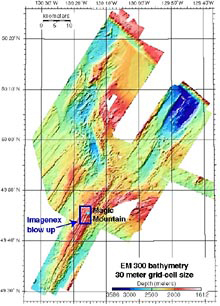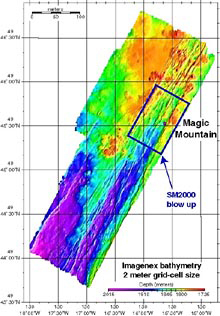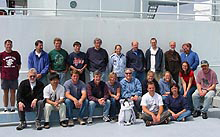
EM300 multibeam bathymetry collected at Explorer Ridge during the first leg of the Ring of Fire expedition. The resolution of the data is 30 meters. The blue box shows the area mapped at higher resolution with the Imagenex sonar mounted on ABE (see second map). Click image for larger view.
First Phase of Submarine Ring of Fire 2002 Ends with Great Success and High Expectations
June 28 - July 11, 2002
Bob Embley, Principal Investigator
NOAA, Pacific Marine Environmental Laboratory
Summary of the Cruise
The 22-member science party of the first phase of the expedition arrived July 11 at Victoria, British Columbia, after working for almost two weeks at Explorer Ridge—the northernmost of the spreading segments off the northwest U.S. and British Columbia coast. For most of the time, the autonomous vehicle (AUV) ABE mapped the seafloor while the research vessel Thomas G. Thompson explored the seafloor and water column over much broader areas.
The first step was to survey the southern Explorer Ridge using the Thompson's new high-resolution EM300 multibeam mapping system. This produced a seafloor map with a horizontal resolution of about thirty meters (roughly the size of a football field). From this map, optimal sites were selected for the sonar beacons (transponders) that would enable ABE to find its way. After the transponders were in place and surveyed to establish their precise position, survey lines for ABE were chosen. Over the next 10 days, ABE faithfully followed the bottom contours up and down the valley staying 40 m above the seafloor in a series of dives lasting up to 18 hours each. In addition to the Imagenex pencil-beam sonar on ABE that provided resolution down to about 2 m (see map below), the SM2000 multibeam sonar was used for the first time. This multibeam sonar is similar to the system mounted on the Thompson's hull, but it has much greater resolving power. This sonar produced startling imagery with about four times the resolving power of the pencil-beam sonar. As the cruise progressed, each step of increased resolution (EM300 to Imagenex to SM2000) revealed new seafloor features (see captions of maps for more detail).

Imagenex pencil-beam bathymetry collected during seven ABE dives in the Magic Mountain area of Explorer Ridge. The resolution of the data is 2 meters. The blue box shows the area mapped at higher resolution with SM2000 sonar, also mounted on ABE (see third map). Click image for larger view.
This expedition marked the first time that a multibeam sonar mounted on an AUV conducted scientific exploratory surveys in the deep ocean. The impressive operational reliability of the ABE that made this possible has been developed over the past 10 years on multiple scientific expeditions. In addition to the high-resolution imagery of the seafloor, other sensors measured temperature, particle concentrations, and electrical properties of the water, plus the variations in the magnetic properties of the seafloor. Taken together, these measurements provide clues to the location and extent of hydrothermal vents and set the stage for the upcoming dives with the remotely operated vehicle ROPOS that will take place later in July. A remotely operated vehicle becomes an immensely more effective tool when used in conjunction with these maps because they are of sufficient resolution that the limited view seen by the ROV cameras can be directly related to features on the map.
In addition to searching for vent sites with ABE, we used a ship-borne sensor system (the CTD package) to systematically map and sample the hydrothermal plumes created by the vents. This effort revealed a series of intense plumes up to 200 m thick overlying the ABE survey area. While much analysis of the plume samples remains to be completed, it is clear that the area hosts one of the largest hydrothermal vent fields yet discovered in the northeast Pacific.

A three-dimensional perspective view of a small portion of the SM2000 multibeam bathymetry collected by ABE in the Magic Mountain area of Explorer Ridge. The resolution of the data is 1 meter. This is the area where most of the ROPOS dives will take place on the next leg of the Ring of Fire expedition. Click image for larger view.
While the focus of the expedition was on the Magic Mountain hydrothermal area on the Southern Explorer Ridge, the science team also explored the spreading centers to the northwest and northeast areas (northern Explorer Ridge and Explorer Deep, respectively) using the CTD package. Although sonar images collected previously reveal young lava flows in some of these basins, we found no hydrothermal plumes during this expedition. The lack of present-day hydrothermal activity in the other segments of Explorer Ridge is probably related to the lesser amount of volcanic activity over time. The Southern Explorer Ridge rises as shallow as 1,800 m, whereas the basins further north are 500 to 700 meters deeper. This simple difference in depth and shape suggests that the Southern Explorer Ridge has experienced a greater supply of magma compared to the rest of the Explorer segment. These rifted basins are reminiscent of the Gorda Ridge that marks the southern portion of the spreading centers of the northeast Pacific.

Standing from left to right (back row) Joe Resing; Bill Chadwick; Rod Catanach; Maurice Tivey; John Lupton; Maureen Carr; Ron Greene; Mike Jakuba; Al Bradley; Al Duester; Sitting from left to right (middle row) Bob Embley; Ko-ichi Nakamura; Geoff Lebon; Ed Baker; Angela Opiola; Sharon Walker; Andrea Toth; Kristen Anderson; Michelle Burkholder; Dana Yoerger; Sitting from left to right (lowermost row) The Penguin, the Thompson mascot; Yannick Beaudoin; Susan Merle. Click image for larger view.
Our efforts with ROPOS will be concentrated over the 4 km of ridge mapped with ABE in the Magic Mountain area, but the whole data set will facilitate more concentrated studies of this section of the Mid-Ocean Ridge in the future. These data also provide a baseline for future volcanic and tectonic events that are sure to occur on this portion of the ridge.
We believe that this expedition is an important new step in the renewed exploration of the oceans. In less than two weeks on site, we were able to characterize the locations and gauge the extent of hydrothermal activity over about 150 km of the mid-ocean ridge. The ABE dramatically expanded the capability of the surface vessel and its systems to explore this complex region.
Sign up for the Ocean Explorer E-mail Update List.






















